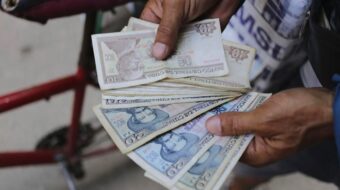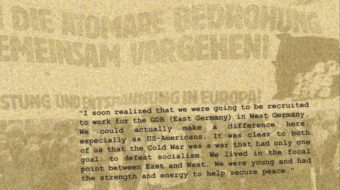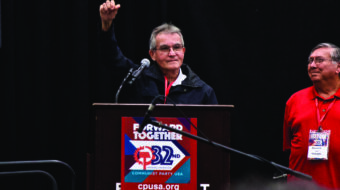The Bank of North Dakota is the only state-owned bank in America. Despite that, or because of it, the bank earned a record profit last year even as its private-sector corollaries lost billions.
Some who have difficulty even absorbing news of a profitable socialist enterprise point to North Dakota’s well-insulated economy, which is heavy on agricultural staples and light on housing speculation, as the source of its success.
But this has not stopped out-of-state politicos from making pilgrimages to Bismarck for counsel and advice. Could opening state-owned banks across America get us out of the financial crisis? The Bank of North Dakota, with its $4 billion under management, has avoided the credit freeze and crisis by creating its own credit, and in doing so, is leading the nation in establishing state economic sovereignty as well. Could decentralizing large sectors of finance provide better insurance – a better hedge, if one may use that term – for the people, against the “too big to fail” phenomenon?
The North Dakota state bank was created 90 years ago, in 1919, as a populist movement swept the northern plains. Basically it was a very angry movement led by farmers against bank and land speculators in Minneapolis, or New York. Those money markets decided who got credit and who did not and who got to market their goods. So a rebellion swept the northern plains. In North Dakota the movement was called the Nonpartisan League, and the League actually took control of the legislature and created what was called an industrial program, which created both the Bank of North Dakota as a financing arm and a state-owned mill and elevator to market and buy the grain from the farmer. And both of those institutions are in existence today doing exactly what they were created to do 90 years ago.
The funding model, or deposit model, is really the unique engine that drives that bank. The state bank is the depository for all state tax collections and fees. In effect, this is a captive deposit base. The bank pays a competitive rate to the state treasurer to help insure competent management. What separates the state bank from private institutions is that the base of deposit funds is plowed back into North Dakota in the form of loans to foster public state economic development activities.
Private banks also invest their deposits. The difference is that the state bank invests a larger portion of that money back into the state’s own economy. Investments are put into agriculture or other economic development programs that are deemed necessary in the state. Energy production, due to ethanol, now plays a huge role there too. The bank does a lot of student loan financing as well. It designs specific loan programs for different business sectors at very low interest rates to encourage activity along certain lines.
The bank has also played a big role in recovery from disasters caused by flooding. It walks a fine line between competing and partnering with the private sector. Most of the lending is participatory in nature. It’s originated by a local bank wherein the state bank can come in and participate and use some of its programs to share risk, or buy down the interest rate. The bank also works to provide guarantees similar to the Small Business Association (SBA) to encourage entrepreneurial startups.
Aside from that, the bank acts as a bankers’ bank or a wholesale bank, providing services to banks, whether it’s check clearing, liquidity, or bond accounting safekeeping. In this sense it acts as kind of a “mini” Federal Reserve.
The advantage of a publicly owned “bankers’ bank” instead of a privately owned one is this: the model employed is to use the deposit base to help other banks with funding their loans, even providing federal funds lines with excess liquidity – by buying and selling fed funds and acting as a clearinghouse for check clearing activity.
North Dakota citizens are fairly conservative and the bank didn’t do any subprime lending. Nor was there a powerful incentive to get into the derivatives markets and put on swaps and callers and caps and credit default swaps. Their philosophy was: “If we don’t understand it, we’re not going to jump into it.” Thus they avoided those pitfalls.
They also provide a dividend back to the state. The Bank of North Dakota stands to make somewhere north of $60 million this year, and will turn over about half of the profits back to the state general fund. And so over the last 12 years, a third of a billion dollars has been returned to the general fund to offset taxes and to aid in funding public sector needs.
The State of North Dakota does not have any funding issues at all. In fact they are dealing with the largest surplus ever. North Dakota state bank deposits are not insured by the FDIC, but by “the people of North Dakota”. Yet the bank has never been a bank that tries to hit home runs. It has a specific mission that is more important. For most corporations and banks, their top priority is to maximize shareholder return. The Bank of North Dakota does have a nice return – a return on net operating assets of 2 percent; a return on equity of 26 percent. But the mission of making sure the needs of the state are met comes first – being able to finance those types of investments that make the state go forward.
When the act that established the North Dakota state bank was enacted, all public corporations in the state were also required to deposit their funds in the bank. However a ballot initiative the same year eliminated that requirement, though not without a big struggle over the issue. Though initially conceived by Nonpartisan League founders as a credit union style institution to free the farmers from predatory lenders, the bank’s functions were partially neutered by the time of its inception by the business-backed “Independent Voters Association.” The recall of NPL Gov. Lynn Frazier in 1921 effectively ended the initial plan, with the bank taking a more conservative central banking role in state finance.
The current president and CEO is Eric Hardemeyer. The bank is managed by the North Dakota Industrial Commission, which is composed of the governor, attorney general, and the agriculture commissioner (formerly the agriculture and labor commissioner) of North Dakota.
Can a “state bank” play a positive role in current struggles for jobs and sustainable recovery? The answer must be YES – although the emergence of such banks must be linked directly to the kinds of investments each state needs to move forward.












Comments